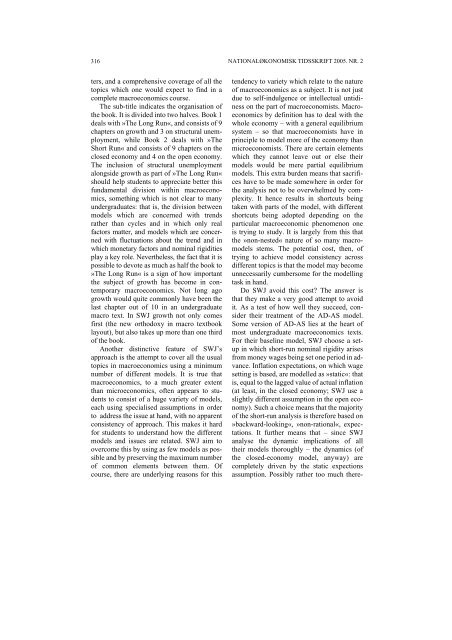samlet årgang - Økonomisk Institut - Københavns Universitet
samlet årgang - Økonomisk Institut - Københavns Universitet
samlet årgang - Økonomisk Institut - Københavns Universitet
Create successful ePaper yourself
Turn your PDF publications into a flip-book with our unique Google optimized e-Paper software.
316<br />
ters, and a comprehensive coverage of all the<br />
topics which one would expect to find in a<br />
complete macroeconomics course.<br />
The sub-title indicates the organisation of<br />
the book. It is divided into two halves. Book 1<br />
deals with »The Long Run«, and consists of 9<br />
chapters on growth and 3 on structural unemployment,<br />
while Book 2 deals with »The<br />
Short Run« and consists of 9 chapters on the<br />
closed economy and 4 on the open economy.<br />
The inclusion of structural unemployment<br />
alongside growth as part of »The Long Run«<br />
should help students to appreciate better this<br />
fundamental division within macroeconomics,<br />
something which is not clear to many<br />
undergraduates: that is, the division between<br />
models which are concerned with trends<br />
rather than cycles and in which only real<br />
factors matter, and models which are concerned<br />
with fluctuations about the trend and in<br />
which monetary factors and nominal rigidities<br />
play a key role. Nevertheless, the fact that it is<br />
possible to devote as much as half the book to<br />
»The Long Run« is a sign of how important<br />
the subject of growth has become in contemporary<br />
macroeconomics. Not long ago<br />
growth would quite commonly have been the<br />
last chapter out of 10 in an undergraduate<br />
macro text. In SWJ growth not only comes<br />
first (the new orthodoxy in macro textbook<br />
layout), but also takes up more than one third<br />
of the book.<br />
Another distinctive feature of SWJ’s<br />
approach is the attempt to cover all the usual<br />
topics in macroeconomics using a minimum<br />
number of different models. It is true that<br />
macroeconomics, to a much greater extent<br />
than microeconomics, often appears to students<br />
to consist of a huge variety of models,<br />
each using specialised assumptions in order<br />
to address the issue at hand, with no apparent<br />
consistency of approach. This makes it hard<br />
for students to understand how the different<br />
models and issues are related. SWJ aim to<br />
overcome this by using as few models as possible<br />
and by preserving the maximum number<br />
of common elements between them. Of<br />
course, there are underlying reasons for this<br />
NATIONALØKONOMISK TIDSSKRIFT 2005. NR. 2<br />
tendency to variety which relate to the nature<br />
of macroeconomics as a subject. It is not just<br />
due to self-indulgence or intellectual untidiness<br />
on the part of macroeconomists. Macroeconomics<br />
by definition has to deal with the<br />
whole economy – with a general equilibrium<br />
system – so that macroeconomists have in<br />
principle to model more of the economy than<br />
microeconomists. There are certain elements<br />
which they cannot leave out or else their<br />
models would be mere partial equilibrium<br />
models. This extra burden means that sacrifices<br />
have to be made somewhere in order for<br />
the analysis not to be overwhelmed by complexity.<br />
It hence results in shortcuts being<br />
taken with parts of the model, with different<br />
shortcuts being adopted depending on the<br />
particular macroeconomic phenomenon one<br />
is trying to study. It is largely from this that<br />
the »non-nested« nature of so many macromodels<br />
stems. The potential cost, then, of<br />
trying to achieve model consistency across<br />
different topics is that the model may become<br />
unnecessarily cumbersome for the modelling<br />
task in hand.<br />
Do SWJ avoid this cost? The answer is<br />
that they make a very good attempt to avoid<br />
it. As a test of how well they succeed, consider<br />
their treatment of the AD-AS model.<br />
Some version of AD-AS lies at the heart of<br />
most undergraduate macroeconomics texts.<br />
For their baseline model, SWJ choose a setup<br />
in which short-run nominal rigidity arises<br />
from money wages being set one period in advance.<br />
Inflation expectations, on which wage<br />
setting is based, are modelled as »static«: that<br />
is, equal to the lagged value of actual inflation<br />
(at least, in the closed economy; SWJ use a<br />
slightly different assumption in the open economy).<br />
Such a choice means that the majority<br />
of the short-run analysis is therefore based on<br />
»backward-looking«, »non-rational«, expectations.<br />
It further means that – since SWJ<br />
analyse the dynamic implications of all<br />
their models thoroughly – the dynamics (of<br />
the closed-economy model, anyway) are<br />
completely driven by the static expections<br />
assumption. Possibly rather too much there-

















